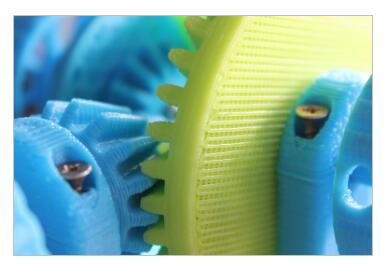3D printing pushing manufacturing to the future

3D printing is not a new phenomenon. Chuck Hull designed a stereolithography process that used ultra violet (UV) lasers to solidify photopolymer in the 1980s, creating 3D parts by layering materials. Now, 40 years later, NASA researchers are using 3D printing to build infrastructure on lunar surfaces. Here on earth, Chris Johnson, CEO of bearing distributor, SMB Bearings, investigates the potential of 3D printing for manufacturing components.
The term additive manufacturing (AM) covers the technologies that create 3D objects by layering materials on top of each other. It encompasses 3D printing, rapid prototyping and additive fabrication. AM is known for its ability to quickly produce complex shapes, without increasing production costs.
Prototyping is one of the most challenging aspects of manufacturing. According to The Economist, “The printing of parts and products has the potential to transform manufacturing because it lowers the costs and risks.” By quickly creating during the product design process, manufacturers can ensure products are made correctly, first time, therefore avoiding the financial impact of remanufacturing.
For small-scale or niche industry manufacturers, rapid prototyping can enable unusual and non-uniform parts to be produced without the heavy initial set up costs for mass production. However, these advantages of 3D printing are well-publicised. Could 3D printing have a role in the creation of traditional manufacturing components?
What’s the case for bearings?
Manufacturing components, like bearings, chains and castors can all be created using 3D printing techniques. However, many believe that the tried and tested methods are the best. Bearings rely on tribology, the science and engineering of surfaces in relative motion, therefore ensuring the material used is fit for purpose is important.
Traditionally, bearings are manufactured out of ceramic or stainless steel. However, using 3D printing, bearings can be made from a variety of materials including plastic, stainless steel, ceramic and even gold or titanium. This means manufacturers can use or try new materials to save costs or push the boundaries of what is expected.
Specific features not possible with traditional bearing design can also be incorporated, which has the potential to improve overall performance. For example, with 3D printing technology bearing cages can also be printed in various synthetic materials, which can then be fitted with standard balls and lubricant. This allows non-standard bearings for high-speed, low friction or corrosive environments to be produced in small quantities.
1.The news above mentioned with detailed source are from internet.We are trying our best to assure they are accurate ,timely and safe so as to let bearing users and sellers read more related info.However, it doesn't mean we agree with any point of view referred in above contents and we are not responsible for the authenticity. If you want to publish the news,please note the source and you will be legally responsible for the news published.
2.All news edited and translated by us are specially noted the source"CBCC".
3.For investors,please be cautious for all news.We don't bear any damage brought by late and inaccurate news.
4.If the news we published involves copyright of yours,just let us know.
Next Keep the Ball Rolling: Bearing Lubrication
BRIEF INTRODUCTION
Cnbearing is the No.1 bearing inquiry system and information service in China, dedicated to helping all bearing users and sellers throughout the world.
Cnbearing is supported by China National Bearing Industry Association, whose operation online is charged by China Bearing Unisun Tech. Co., Ltd.
China Bearing Unisun Tech. Co., Ltd owns all the rights. Since 2000, over 3,000 companies have been registered and enjoyed the company' s complete skillful service, which ranking many aspects in bearing industry at home and abroad with the most authority practical devices in China.

